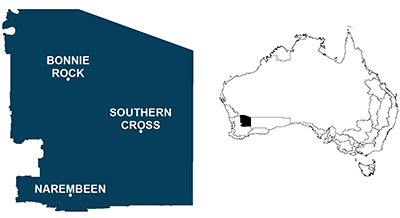
WA Eastern Regional Summary

The region
The WA Eastern agroecological zone is centered around Merredin and extends to Mount Gibson in the north and Narembeen in the south. Rainfall in the zone averages around 400 mm annum-1 and rainfall seasonality is winter-dominant. Boundaries for the zone are shown in Figure 1.
Modelling regional practices
Producing models that reflect all farming practices throughout a region is difficult so “common practice” models for wheat and lupins for the region were produced. A wheat crop with a 1.0 t ha-1 yield and 13 kg of fertiliser N applied ha -1 and a lupins crop with a yield of 0.4 t ha-1 and 2 kg of fertiliser N ha -1 applied were modelled. The key assumptions of these models were that;
- Only one pass was made at sowing
- Split fertiliser applications were used for canola crops
- It was assumed that wheat and lupins crops had two fallow sprays. Wheat and lupins had one in-crop herbicide and lupins also had one pesticide application.
- Stubble was retained
- Lime was applied at the equivalent rate of 4 t ha-1 every decade and incorporated through scarification
Impact indicators
Hydrogen ion impacts estimate the release of hydrogen ions to the soil associated with crop production. A negative value indicates a reduction in soil acidity whereas a positive value indicates an increase in soil acidity. Soil erosion is an estimate of soil loss that occurs during the production of the crop. The depth of soil lost will depend on many things but an approximate conversion is that 1.5 t of soil loss equals 1 mm of soil. Global warming impacts are the release of greenhouse gases to the atmosphere expressed as carbon dioxide equivalents (CO2-e), Eutrophication impacts are the release of phosphorous to the environment and are expressed as phosphate equivalents and Particulate Matter impacts are the release of fine particles less than 2.3 micrometres in diameter.
Benchmark results
Results below in Table 1 show the environmental impacts of producing a t of wheat or lupins in the region. Lime use in the region resulted in a reduction in free hydrogen ions in the soil for all crops and soil erosion was estimated at between 5.6 and 12.2 t soil loss t product-1. Analysis indicated that Global warming impacts associated with the production of these crops ranged from between 351 and 418 kg CO2-e, Eutrophication impacts ranged between 1.7 and 2.1 kg PO4-e and Particulate Matter impacts ranged between 0.45 and 0.46 kg of < 2.3 µm particulate matter t product-1.
Table 1: Hydrogen ion changes, soil erosion and Global Warming, Eutrophication and Particulate matter impacts associated with the production of wheat and lupins in the WA Eastern agroecological zone.
Hydrogen ions | Soil erosion | Global warming | Eutrophication | Particulate matter | |
|---|---|---|---|---|---|
(kg H+) | (t soil loss) | (kg CO2-e) | (kg PO4-e) | (kg PM2.3) | |
Wheat | -372.72 | 5.64 | 418.44 | 1.71 | 0.45 |
Lupins | -814.55 | 12.18 | 351.15 | 2.07 | 0.46 |
Greenhouse gas emissions
The emissions profile for wheat and lupins grown in the region are shown below in figure 2. For wheat, the greatest source of emissions was from the use of fertiliser and transport and lime production and use made the least greatest contribution to total emissions. Residue emissions made the greatest contribution to the total emissions of lupins production but fertiliser production and use, tractor operations and chemical production also made considerable contributions to total emissions.
Figure 2: Greenhouse gas emissions profile for the production of wheat and lupins in the WA Eastern agroecological zone.Greenhouse gas mitigation strategies
Mitigation strategies tested for the region were;
- Sustainable intensification
- Additional applications of lime
- Implementation of variable rate fertiliser technology
- Changing a wheat-wheat rotation to a legume-wheat rotation
More information on the assumptions used to test these strategies and how they might reflect individual enterprises are available on the Mitigation strategies page.
Results (figure 3 below) indicate that emissions of a t of wheat can be reduced by;
- 42% through the implementation of sustainable intensification
- 33% by additional lime applications
- 12% by implementation of variable rate fertiliser technology
Results also indicate the replacing a wheat crop with a legume crop in a two-crop rotation can increase greenhouse gas emissions intensity by 118%.
Figure 3: Reductions in greenhouse gas emissions for wheat production when grown with sustainable intensification, variable fertiliser, additional lime applications and legume - wheat mitigation strategies in the WA Eastern agroecological zone.
Accessible content
Visit accessible versions of the raw data used to generate these charts.
More information
Dr Aaron Simmons
Orange Agricultural Institute
1447 Forest Road
Orange NSW 2800
P: 02 63913894
E: aaron.simmons@dpi.nsw.gov.au

